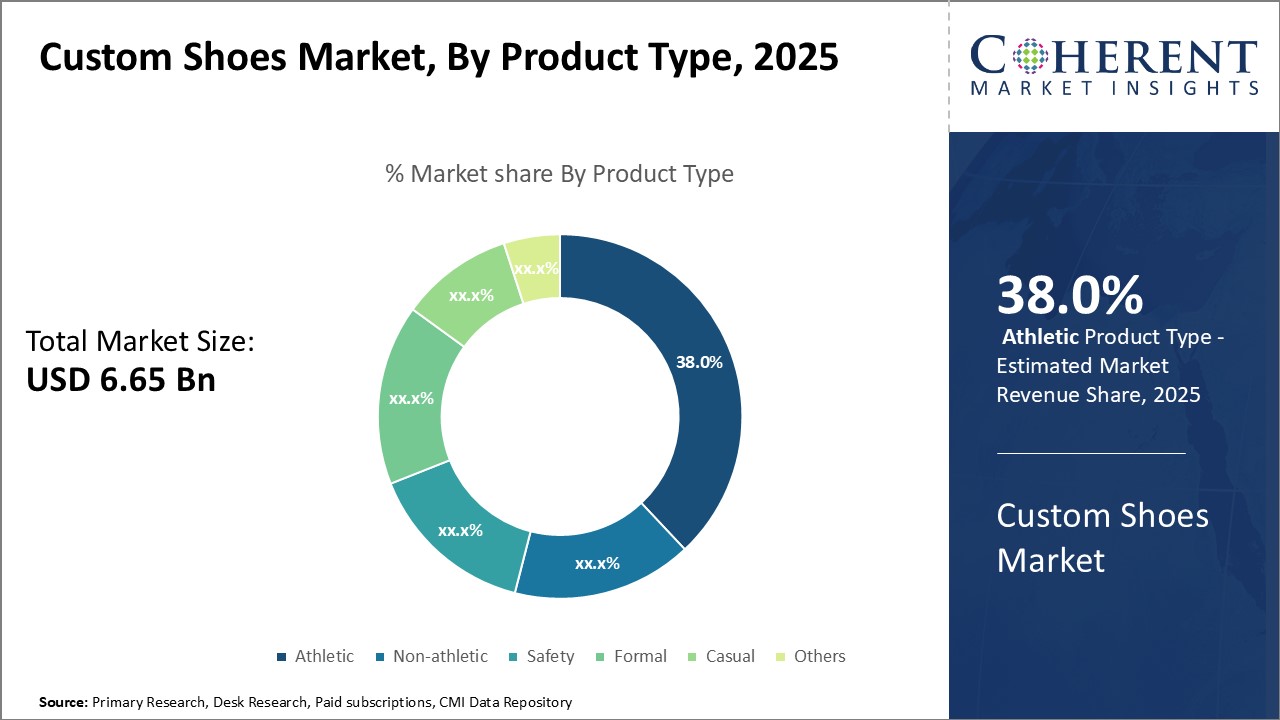The custom shoes Market size was valued at US$ 6.65 Bn in 2025 and is expected to reach US$ 14.7 Bn by 2032, growing at a compound annual growth rate (CAGR) of 12.0% from 2025 to 2032.
Custom shoes allow consumers to design and customize their own footwear based on style, fit, color, materials, and other preferences. The key advantage is getting a personalized product tailored to individual needs. The growth drivers include increasing demand for customized products, rising fashion consciousness, higher disposable incomes, and new innovations in materials and manufacturing processes.
The custom shoes market is segmented based on product type, material type, end user, distribution channel, design, and region. By product type, the athletic segment held the largest share of over 40% in 2025. The rising popularity of athletic and sport-inspired footwear is driving the demand for customized athletic shoes.
Custom Shoes Market Regional Insights
- North America is expected to be the largest market for custom shoes during the forecast period, accounting for over 35% of the market share in 2025. The growth of the market in North America is attributed to high disposable incomes and a culture embracing customization and personalization.
- Asia Pacific is expected to be the second-largest market for custom shoes, accounting for over 25% of the market share in 2025. The growth of the market in Asia Pacific is attributed to a large population base and increasing fashion consciousness in the region.
- Latin America is expected to be the fastest-growing market for custom shoes, growing at a CAGR of over 15% during the forecast period. The growth of the market in Latin America is attributed to improving economic conditions and growth of e-commerce platforms making customized shoes more accessible.
Figure 1. Global Custom Shoes Market Share (%), by Region, 2025

To learn more about this report, Download Free Sample
Custom Shoes Market Drivers
- Increasing demand for personalized products - The demand for customized and personalized products is on the rise across several industries including footwear. Consumers increasingly want shoes that reflect their personality and match their individual needs. For instances, As per the news release, The custom shoes market is being driven by customers looking for one-of-a-kind designs made just for them. Several footwear brands now offer online shoe customization platforms where buyers can design their own shoes. This shift towards personalization is expected to significantly boost the custom shoes market.
- Innovations in manufacturing technologies - The custom shoes market growth is aided by innovations in digital manufacturing technologies like 3D printing and computer-aided design (CAD) software. For instances, According to the engineering.com,3D printing enables the on-demand production of customized shoe designs without the need for bulk manufacturing. CAD software allows creating customized shoe lasts and patterns tailored to the customer's specifications in a digital environment. These technologies empower companies to provide tailored products at scale. Several startups are disrupting the market by leveraging such innovations.
- Increasing fashion consciousness - Rising fashion awareness and the growing sneaker culture, especially among millennial, is propelling the demand for exclusive and customized shoes that can reflect the wearer's style. Young consumers are willing to pay a premium for scarce, one-of-a-kind sneakers, and footwear. The shift towards expressing individuality through fashion is expected to be a key factor spurring the growth of the custom shoes market.
- Entry of large brands - Large athletic footwear companies like Nike, Adidas, New Balance, and Puma have recently launched their own shoe customization services. The entry of established brands with their production expertise and marketing resources is significantly expanding the reach of custom shoes. Their involvement validates the market potential and promotes consumer awareness. This is anticipated to catalyze the market growth.
Custom Shoes Market Opportunities
- Growth of online retail - The rapid growth of e-commerce provides huge opportunities for expansion to players in the custom shoes market. Online configurators allow a seamless customization experience. Digital printing enables production of customized shoes in small batches. Ecommerce provides access to wider consumer segments, flexibility in manufacturing and ability to offer greater personalization. Investing in digital capabilities can help companies capitalize on the potential of online retail.
- New markets with untapped potential - Developing countries in Asia Pacific, Africa, and Latin America present significant business opportunities for the custom shoes market. Large young populations, rising incomes, and increasing internet penetration make these regions highly attractive for expansion. Localization and partnerships with regional companies can help tap into the sizable untapped potential. Catering to regional tastes and trends can further fuel the market growth.
- Product line extensions - Custom shoe companies can leverage their technical expertise to extend into newer segments like mass customization of casual lifestyle shoes, children's footwear, work shoes, etc. Cross-selling opportunities also exists in customized orthotics, insoles, accessories, and shoe care products for existing clients. New 3D printed materials allow customization possibilities beyond just aesthetics. Broadening product portfolios can be a lucrative growth strategy.
- Applications in medical shoes and prosthetics - Custom footwear has promising applications in the healthcare industry for conditions like diabetes, plantar fasciitis, and pronation. 3D scanning and printing can enable tailored medical shoes with perfect fit. For instances, According to the Davis shoes therapeutics, Customization also has potential for prosthetic shoes and limbs for the disabled. Partnering with medical technology firms and investing in R&D can unlock major innovation opportunities.
Custom Shoes Market Report Coverage
| Report Coverage | Details | ||
|---|---|---|---|
| Base Year: | 2024 | Market Size in 2025: | USD 6.65 Bn |
| Historical Data for: | 2020 To 2024 | Forecast Period: | 2025 To 2032 |
| Forecast Period 2025 to 2032 CAGR: | 12.0% | 2032 Value Projection: | USD 14.7 Bn |
| Geographies covered: |
|
||
| Segments covered: |
|
||
| Companies covered: |
Nike, Adidas, New Balance, Puma, Asics, Skechers, Vans, Converse, Sperry, Crocs, Timberland, Clarks, ECCO, Wolverine Worldwide, Deckers Brands, Aldo Group, Genesco, Steve Madden, Caleres, and GEOX |
||
| Growth Drivers: |
|
||
| Restraints & Challenges: |
|
||
Uncover macros and micros vetted on 75+ parameters: Get instant access to report
Custom Shoes Market Trends
- Digitalization and integration of technologies - The custom shoes market is undergoing digital transformation. Companies are integrating technologies like 3D printing, computer-aided design, and Augmented reality/ Virtual reality ( AR /VR) to provide digitally-enabled customization options. The adoption of digital tools allows rapid design iterations, virtual try-ons, accurate measurements, and on-demand localized manufacturing. Integration of digital workflows fosters greater personalization, efficiency, and sustainability.
- Focus on eco-friendly manufacturing - Sustainability is an emerging trend in the custom shoes sector. Companies are utilizing recycled materials like plastics, rubber, and cotton for 3D printed midsoles, laces, and linings. Renewable resources like bamboo and cork as well as environment-friendly synthetic materials are also gaining traction. The emphasis is on reducing waste during production through digitalization and adopting circular manufacturing principles. Consumers increasingly prefer brands with eco-friendly practices.
- Direct-to-consumer business models - Many custom shoe brands are adopting direct-to-consumer e-commerce models to achieve better vertical integration, higher margins, and ownership of customer experience. Online customization platforms help collect data and gain insights directly from consumers. For instances According to the Alix Partner, Direct distribution also enables fulfillment from localized microfactories. This improves lead times and optimizes inventory. The D2C model allows for more flexible, sustainable, and cost-efficient value delivery.
- Usage of performance materials - Advanced materials like Flyknit, Primeknit, and biomechanically-engineered foams are being incorporated by custom shoe companies to enhance fit, function, and comfort. For instances According to the Engineering innovations, Companies are also offering add-ons like GPS tracking and step-counting sensors for athletic consumers. Usage of responsive materials, robotics technologies, and electronic components indicates a shift towards performance-centric customization beyond just aesthetics.
Custom Shoes Market Restraint
- High cost of customization - Offering personalized products at scale remains a challenge. Modification and smaller batch production runs increase manufacturing costs. Customized shoes also involve expenses for design software, 3D printing systems, and skilled labor. Consequently, the retail prices for customized sneakers are much higher, making them unaffordable for the masses. The high costs and premium pricing limits the addressable market size, restricting widespread adoption.
- Counter Balance: The custom shoes market is expected to experience significant growth in the coming years due to rising demand for personalized and versatile footwear.
- High Manufacturing Time - The entire process from customization to manufacturing takes considerably longer compared to mass-produced shoes. The multiple steps of iteration and approvals elongate order fulfillment timelines. While technologies like 3D printing enhance prototyping, the final manufacturing stage remains time-intensive. The longer wait times negatively affect consumer experience and satisfaction.
- Counter Balance: Use new innovative ideas to overcome the time duration and increases the quality of products by using new technologies.
- Lack of expertise - Shoe customization requires specialized technical capabilities spanning design software, scanning solutions, materials knowledge, and digital manufacturing. Companies need data scientists, 3D modelers, and programmers to build robust mass customization platforms. Such experts are hard to find. The learning curve for leveraging new technologies is also steep. The talent gap can hamper the scalability and maturation of the custom shoes market.
Custom Shoes Market - Recent Developments
New product launches
- In March 2021, Nike, Inc. is an American athletic footwear and apparel corporation headquartered near Beaverton, Oregon, United States. Nike launched Nike By You, allowing consumers to customize and personalize Nike footwear with various design options. This boosted Nike's presence in the custom shoes segment.
- In January 2022, Adidas AG is a German athletic apparel and footwear corporation headquartered in Herzogenaurach, Bavaria, Germany. Adidas introduced its customizable Adidas A-ZX sneakers range in the U.S. market. The shoes can be customized with unique color and print combinations.
- In April 2020, Puma introduced its customizable Puma Customize Franchise, entering the custom athletic footwear market. Consumers can customize styles, colors, and add personal IDs.
Acquisition and partnerships
- In October 2021, Nike acquired TraceMe, a startup that enables customized experiences through digital engagement. This supports Nike's direct-to-consumer strategy.
- In May 2022, Adidas partnered with long-time supplier AMS Fulfillment to expand its U.S. customization capabilities for footwear
Figure 2. Custom Shoes Market Share (%), By Product Type, 2025

To learn more about this report, Download Free Sample
Top Companies in the Custom Shoes Market
- Nike
- Adidas
- New Balance
- Puma
- Asics
- Skechers
- Vans
- Converse
- Sperry
- Crocs
- Timberland
- Clarks
- ECCO
- Wolverine Worldwide
Definition: The custom shoes market refers to the industry catering to the demand for personalized and tailored shoes designed based on individual preferences. Using innovative manufacturing techniques and technologies, custom shoe companies offer customized options in style, color, print, fit, comfort, materials, and other requirements for footwear tailored to the buyer's needs and specifications. Custom shoes can be ideal for athletic performance, lifestyle wear, comfort, fashion, safety, or medical reasons. The market has seen rapid growth with online custom shoe configurators and rising consumer demand for one-of-a-kind products.
Few Other Promising Reports in the Consumer Goods Industry
Portable Security Cabin Market
Share
Share
Missing comfort of reading report in your local language? Find your preferred language :
Transform your Strategy with Exclusive Trending Reports :
Frequently Asked Questions
Select a License Type
EXISTING CLIENTELE
Joining thousands of companies around the world committed to making the Excellent Business Solutions.
View All Our Clients




